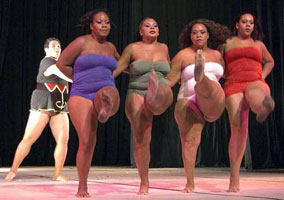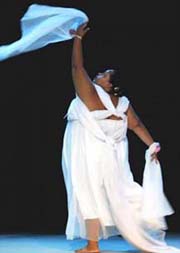 Danza Voluminosa is like any other professional dance troupe, only heavier – a lot heavier, writes Geraldine
Royds
Danza Voluminosa is like any other professional dance troupe, only heavier – a lot heavier, writes Geraldine
Royds
With most members weighing over 200 pounds,
the founder, Juan Miguel Mas, says he created the group to make a political as
well as an artistic statement. ‘We obese people also need to express
ourselves with our bodies,’ he says. ‘We feel our bodies, we command them and
we enjoy them just like any other human being.’ The troupe has overcome ridicule to win applause
for their exuberant performances, selling-out shows in
Danza
Voluminosa was founded in 1996 by Juan Miguel Mas, a dancer who was frustrated
at the lack of opportunity for overweight people like himself to perform.
Mas, who first
appeared on stage with
‘The main idea
was to create a space where obese people could learn the art of dancing. Here
we have created a style of dance that's suited to large bodies,’ says Mas, who
is choreographer an
The ballerinas
don’t pirouette, spin and leap like conventional dancers. ‘Fat people move
differently,’ says Mas, explaining that the choreography reflects this. The
movements are more earth-bound and they often dance close to the ground,
crouching, kneeling or lying on the floor. Their slow turns and arm movements create waves of motion, rippling
through their bodies.
A fan, (on the
website, Ballet Talk) describes a performance:
‘I must confess it took me a little bit to get used to the physique of the
dancers. Then I tried to concentrate on the story. They presented "Phaedra",
the tragic Greek myth … at the end they danced to the resurrection
of Phaedra and Hippolytus in a climax of
Juan
Miguel Mas admits that he often uses humor to bring the public in - the group’s
parody of ‘
‘Our work is not just art, it also has a social
aspect,’ Mas says. ‘We approach obese people to help them find a physical and
emotional equilibrium and rescue their self-esteem.’ 
For many of the
dancers, working with Danza Voluminos has changed their lives. Barbara Paula
Valdes, 27, said she feels transformed after two years with the company.
‘I changed how
I walk, how I talk, the way I relate to people,’ said Valdes, ‘I had an artist
hidden inside me an
Another dancer,
who has been with the troupe for five years, says it still feels strange at
times to be on stage, as if she is constantly discovering the potential beauty
hidden inside her body, which for years was a source of shame for her.
After years of
struggling for resources, the group now has official sanction and can practice
and perform in the National Theatre of Cuba. Mas receives a government salary
although the dancers mostly fit rehearsals and performances around their
regular jobs.
Danza Voluminosa has been
challenging stereotypes and expanding the boundaries of contemporary dance in
